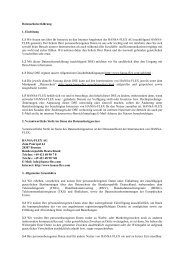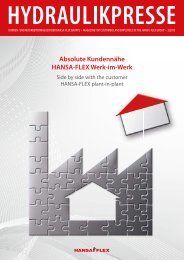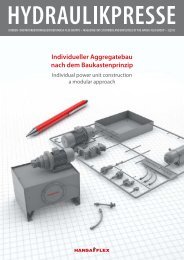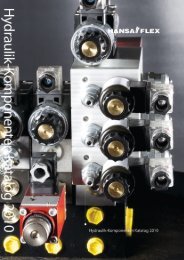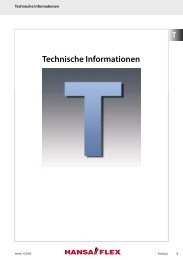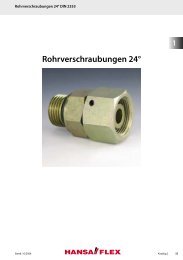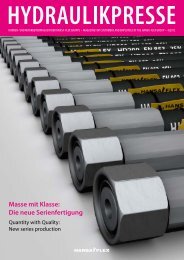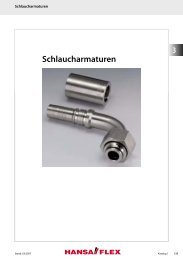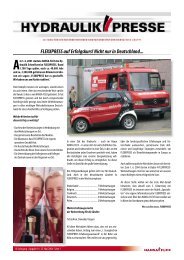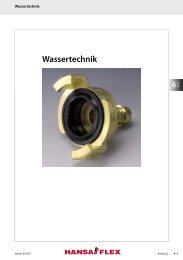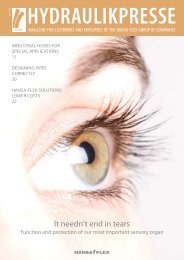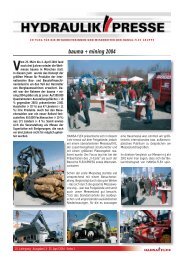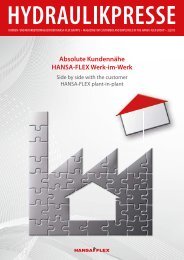Hydraulikpresse - Hansa Flex
Hydraulikpresse - Hansa Flex
Hydraulikpresse - Hansa Flex
Sie wollen auch ein ePaper? Erhöhen Sie die Reichweite Ihrer Titel.
YUMPU macht aus Druck-PDFs automatisch weboptimierte ePaper, die Google liebt.
fascination technology faszinaTion TecHnik<br />
HiGH illuMinance led TorcHes These days, leds are<br />
used in much more than just pocket torches, they are also<br />
found in all kinds of signal and street lights, even in vehicle<br />
headlights.<br />
watt bulb, they consume barely 8 watts.<br />
further advantages of leds are their long<br />
service life, freedom from maintenance,<br />
low energy consumption, colour stability and<br />
impact resistance.<br />
light emitting diodes are referred to as electroluminescence<br />
radiators. they are based on semiconductor<br />
connections. they are powered by a low voltage and<br />
there are usually several diodes in a module. for led<br />
light in conventional lamps, the lighting industry offers<br />
rgB led modules, which are housed in a light<br />
source in the shape of a light bulb and have an e27<br />
screw-in base. in a “normal” residential light fixture,<br />
they can emit white light for general and area illumination,<br />
or coloured, atmospheric lighting in red,<br />
green and blue as desired.<br />
HoW iT all beGan<br />
be explained for another 60 years. in 1907, henry<br />
Joseph round was the first person to observe that<br />
inorganic substances are capable of emitting light in<br />
response to an applied voltage. in 1921, the russian<br />
physicist oleg lossew rediscovered the round effect<br />
and investigated it in detail until 1942. he supposed<br />
that the phenomenon could be characterised as a reversal<br />
of einstein’s photoelectric effect. then in 1951<br />
georges destriau discovered a similar illuminating<br />
phenomenon with zinc sulphide, and he named it<br />
lossew light in honour of the russian physicist.<br />
when the transistor appeared in 1951, it drove<br />
scientific advances in semiconductor technology.<br />
after 1957, semiconductors were the core element<br />
in researching light generation. there is still some<br />
argument about who really invented led lighting.<br />
according to some sources, the light emitting diode<br />
was invented by nick holobyak in 1962.<br />
the origins of semiconductor development lie in<br />
a scientific discovery that was ignored for many<br />
after their development, initially leds were used<br />
mainly for orientation lights. now they can be found<br />
led worK without<br />
relYiNg oN MercurY or<br />
other toXic SuBStaNceS<br />
years. in 1876, ferdinand Braun delivered a lecture<br />
on the conductivity of crystals. he described his<br />
experiments, in which he held a metal tip against<br />
a sulphide crystal and discovered that in one direction<br />
the crystal acted as a good conductor, but in the<br />
other it conducted poorly. in addition, he noted, the<br />
crystal’s conductivity increased steadily in the one<br />
direction as the electrical current was increased. in<br />
those days, science only knew about ohmic conductors<br />
and insulators. the scientific community was bewildered,<br />
because this effect was completely at odds<br />
with the properties of materials that were known<br />
at the time. this remarkable behaviour would not<br />
in car headlights, torches, and signal and street<br />
lighting. But it will undoubtedly be a while before<br />
the light emitting diode finds its way into our living<br />
rooms. Besides its high purchase price, many people<br />
are discouraged from buying it due to the type of<br />
light emitted. while there are now leds that produce<br />
white light, many people find the light they produce<br />
too “cold”. changing this situation is the primary task<br />
of the light designers with several different lighting<br />
manufacturers. until we reach that point, there are<br />
still many other good arguments on behalf of the<br />
led.<br />
HYDRAULIKPRESSE 1|2011<br />
45



